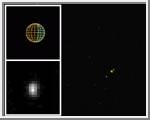|
COMETS EARTH JUPITER KUIPER BELT MARS MERCURY METEORITES NEPTUNE OORT CLOUD PLUTO SATURN SOLAR SYSTEM SPACE SUN URANUS VENUS ORDER PRINTS
PHOTO CATEGORIES SCIENCEVIEWS AMERICAN INDIAN AMPHIBIANS BIRDS BUGS FINE ART FOSSILS THE ISLANDS HISTORICAL PHOTOS MAMMALS OTHER PARKS PLANTS RELIGIOUS REPTILES SCIENCEVIEWS PRINTS
|
Related Document
Download Options
The brightest of Jupiter's outer satellites, Himalia, was captured and resolved, for the first time, in a series of narrow angle images taken on December 19, 2000 from a distance of 4.4 million kilometers during the brief period when Cassini's attitude was stabilized by thrusters instead of reaction wheels. This particular 1.0 second exposure was one of the sharpest, with a resolution of ~ 27 km/pixel, and was taken through a near-infrared spectral filter at 1:07 UTC (spacecraft time). The arrow indicates Himalia. North is up. The inset shows the satellite magnified by a factor of 10 and a graphic indicating Himalia's size and phase (the sunlight is coming from the left). It is likely that Himalia is not spherical: it is believed to be a body captured into orbit around Jupiter and as such, is likely to be an irregularly shaped asteroid. At the time this image was acquired, the dimensions of the side of Himalia facing the cameras is roughly 160 km in the up/down direction. |
